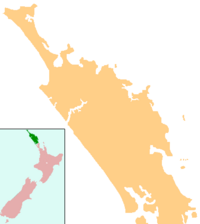Kaikohe Aerodrome facts for kids
Quick facts for kids
Kaikohe Aerodrome
|
|||||||||||||||
|---|---|---|---|---|---|---|---|---|---|---|---|---|---|---|---|
| Summary | |||||||||||||||
| Operator | Far North Holdings Ltd. | ||||||||||||||
| Location | Kaikohe, New Zealand | ||||||||||||||
| Coordinates | 35°27′10.22″S 173°49′0.17″E / 35.4528389°S 173.8167139°E | ||||||||||||||
| Map | |||||||||||||||
| Runway | |||||||||||||||
|
|||||||||||||||
Kaikohe Aerodrome is an airport located near Kaikohe in New Zealand's Northland area. It was built in 1942 as a base for US Marine bombers during World War II.
Today, it's the biggest grass runway in the Southern Hemisphere. Many different types of aircraft use it, including general aviation planes. Besides regular planes, gliders also fly from here. You might even see model airplanes flying in a special area. Plus, people go skydiving here, landing near the old airport building.
Contents
History of Kaikohe Airport
Kaikohe Airport was built in 1942 during World War II. It was created to be a base for US Marine bomber planes.
The airport was built on a flat area of land called a plateau. This spot was chosen because it was large and flat, with strong volcanic rock underneath. This made it a perfect place for an airport. Its main runway was the longest in Northland. It was strong enough for heavy bomber planes to land, which was special for airports in the area. A railway line, the Okaihau Branch Railway, used to go around the airport, but it closed in 1987. The airport had one long main runway and a shorter one that crossed it at a right angle.
From Military to Civilian Use
After the war, the airport changed to be used by regular people and planes. On January 23, 1947, New Zealand National Airways Corporation (NAC) started its first passenger flights from Kaikohe. These flights went to Kaitaia in the north and to Whangarei and Auckland in the south.
Planes like the Lockheed Electra and de Havilland Dominie were used. Later, on May 15, 1950, NAC brought in larger Lockheed Lodestar planes. These planes could not use Whangarei's airport, so Kaikohe had a direct flight to Auckland. This new service was great for Kaikohe. It meant more seats for passengers and more space for cargo. The flight time to Auckland also became shorter, from 70 minutes to 45 minutes.
Changes in Air Service
The Lodestar planes didn't stay long on the Northland route. On April 2, 1951, Douglas DC-3 planes started flying the Auckland - Kaikohe - Kaitaia route. The separate service from Whangarei was stopped at the same time. The DC-3 service continued until 1964. After that, flights from Auckland to Kaikohe started going through Whangarei again.
By 1967, the air service to Kaikohe was in trouble. It had the fewest passengers of any NAC destination. In 1969, only about 5,000 passengers used Kaikohe Airport. This was an average of just seven people flying in and seven flying out each day. In 1970, Kaikohe lost its air service with NAC. This was because of the low number of passengers. Also, the DC-3 planes were being replaced by larger Fokker Friendship planes. These new planes could not land safely on the uneven grass runways at Kaikohe.
Later Air Services and Current Use
In July 1970, Geyserland Airways started flying an Auckland-Kaikohe service. They used an Aero Commander 680FL aircraft. This service did well. In 1972, a new airline called Air North took over this service.
In 1975, Mount Cook Airline began flying into Kerikeri Airport. This meant fewer passengers for Kaikohe Airport. People now had another option for flying into the Bay of Islands. Air North passed its flight rights to the Auckland Aero Club in 1978. This service stopped in 1982. In 1983, a new airline called Mid North Air started flights to Kaikohe. However, this was not profitable and ended the same year.
This was the end of regular passenger flights to Kaikohe. The paved runway in Kerikeri was much better for airlines flying into the Bay of Islands than Kaikohe's grass runway.
Over the next few years, the airport became popular for gliding. It also became a base for local planes that spread fertilizer on farms. Skydiving operations also became common.
Airport Operations
- Lighting: There is no lighting for night operations.
- Fuel: You can get Air BP Avgas fuel using a swipecard.
Glider Activities
Gliders often use the airfield. They usually use Runway 17/35 on the west side. Powered aircraft use the other side of the runway when gliders are flying. The runway is 140 meters wide. It is split so that powered aircraft use a 60-meter wide section. The rest of the runway is for gliders. However, if there is an emergency landing, all three runways are open for use. Gliders usually fly on Thursdays and weekends.


